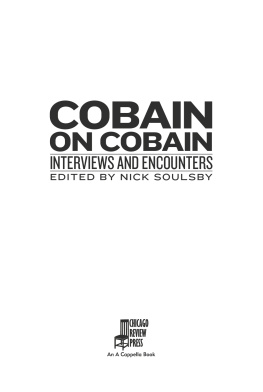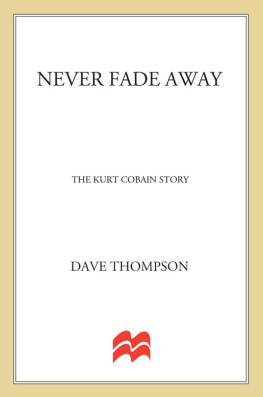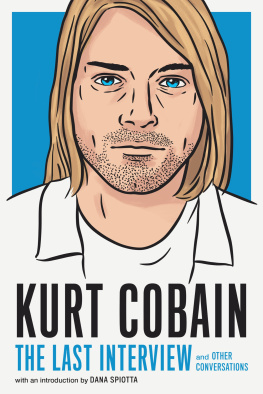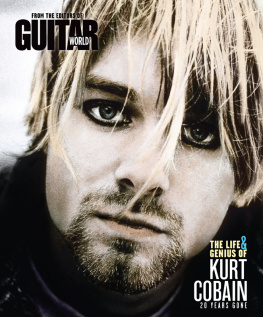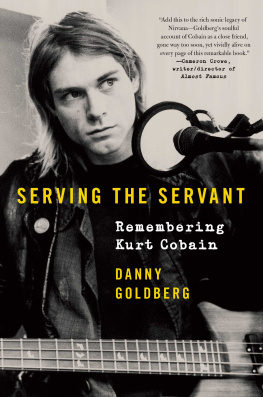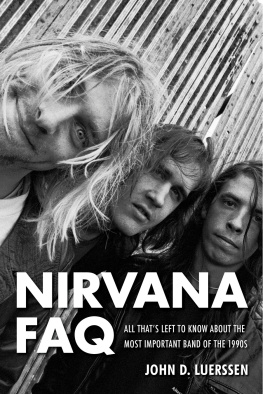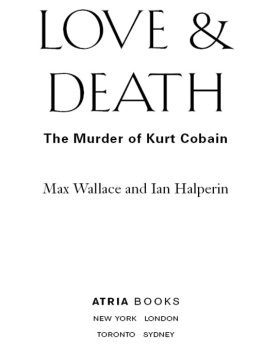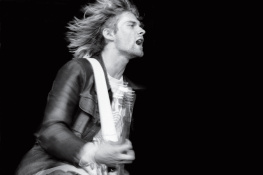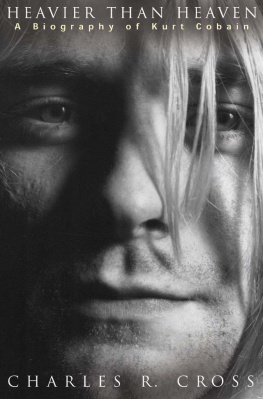OTHER BOOKS IN THE MUSICIANS IN THEIR OWN WORDS SERIES
Bowie on Bowie: Interviews and Encounters with David Bowie
Coltrane on Coltrane: The John Coltrane Interviews
Hendrix on Hendrix: Interviews and Encounters with Jimi Hendrix
Judy Garland on Judy Garland: Interviews and Encounters
Keith Richards on Keith Richards: Interviews and Encounters
Led Zeppelin on Led Zeppelin: Interviews and Encounters
Leonard Cohen on Leonard Cohen: Interviews and Encounters
Miles on Miles: Interviews and Encounters with Miles Davis
Springsteen on Springsteen: Interviews, Speeches, and Encounters
Tom Waits on Tom Waits: Interviews and Encounters
Copyright 2016 by Nick Soulsby
All rights reserved.
Published by Chicago Review Press Incorporated
814 North Franklin Street
Chicago, Illinois 60610
ISBN 978-1-61373-097-3
Library of Congress Cataloging-In-Publication Data
Cobain on Cobain : interviews and encounters / edited by Nick Soulsby.
pages cm
Includes index.
ISBN 978-1-61373-094-2 (cloth)
1. Cobain, Kurt, 19671994Interviews. 2. Rock musiciansUnited StatesInterviews. 3. Nirvana (Musical group) I. Soulsby, Nick, editor.
ML420.C59C62 2016
782.42166092dc23
[B]
2015029431
Interior design: Jonathan Hahn
Interior layout: Nord Compo
Printed in the United States of America
5 4 3 2 1
This digital document has been produced by Nord Compo.
INTRODUCTION
For more than two years, Nirvana was barely worth a mention in the press or on air. After six months of practicing, the band had plucked up enough courage to play a house party in March 1987. A full year later theyd finally settled on a band name. Another year later theyd played only three gigs outside the state of Washington. Who were they? Two original songs and a cover shared via limited edition releases on a label, Sub Pop, that had only local cachet and was forever teetering on the brink of bankruptcy.
Two years after that, in 1991, Nirvana, now on a major, with a solid reputation in the underground as one to watch, was preparing demos for a sophomore album to be titled Nevermind. Theyd toured the United States four or five times and Europe twice, and their first album, Bleach, in the summer of 1989 was followed by an EP, a couple of singles, and a couple of compilation tracks. But for most of 1991 no one paid them much mind outside the same circles of punk fanatics, grunge addicts, rock aficionados, and college students who made up their normal audience.
The next two-year leap was exponential: millions of records sold, shows on five continents. Those songs of 1991 had launched the band into a stratosphere lit by paparazzi flashbulbs and stadium effects rigs. The bands front man, Kurt Cobain, was married, a father, a rich man, the acclaimed voice of a generation, writer of the anthem that rebuilt rock music... and was condemned as a malcontent, a bad influence, a depressive, a drug addict. By 1993 Nirvana had already prepared what, unbeknownst to them, would be their final statement, In Utero.
Two more years: 1995. Fans greeted the one-year anniversary of Nirvanas collapse and soon turned to commemoration of Cobains death at his home in Seattle around April 5, 1994only six and a half weeks after he had turned twenty-seven.
What happened?
Well, its not like Kurt Cobain set out to become a plumber. From the start, his desire was to live from his music, to perform and to display his art before an audience, to be appreciated. The Faustian bargain was made at the outset: he wanted to be seen, to be heard, and he needed the help of radio, newspapers, television, and magazines for that to happen.
This bargain is at the heart of Cobain on Cobain. In this book well follow the relationship between Kurt Cobain, his band Nirvana, and the media that he would alternately curse or court, from the bands earliest interviews to their last. The words of the artists themselves will be our guide.
The relationship between Cobain and the media was a fraught one. After those first two years in the wilderness, Cobain measured his progress by dropping a quarter in a pay phone slot and requesting his bands first single on local radio. Its how bands function: they play, people listen, theyre played, people pay, they speak to persuade more people to hear them, to see them play, to listen, to pay. The media isnt something a band engages withits fundamental to a bands existence, a part of the look, sound, concept, and image that make an artist.
And in the bands early days there wasnt enough media attention for Cobains liking. In 1988, as far as is known, the band earned a solitary article in a local music magazine. In early 1989, scattered quotes appeared in barely half a dozen placesthe bands first tour that summer raised perhaps two brief commentaries. Nirvana wasnt worthy of press comment because the group was an unknown factor; their first album didnt emerge until June 15, 1989, and the record and their touring needed more time to gain them a following.
Cobain would later cite this lack of coverage as a reason he was unhappy on Sub Pop. He would further claim that the record label presented Nirvana as rednecks or ignorant wild men. Regardless of the truth, the crucial point, the key factor in Cobains relationship with the press, was that Cobain wanted to perform and be understood on his own terms. It was the same reason hed underperformed in school despite his obvious intelligence, the same reason hed been loath to hold down any formal work in his young lifehe was completely resistant to the compromises that school, family, jobs, and employers impose. Music had suggested a path via which his unmediated self could be expressed, when he wanted and how he wanted. This was something he was willing to work very hard for. To find that being on a record label meant someone else playing a role in defining who he was came as an undesirable imposition; youre in high school again, he sang.
He was willing to bend and accept some things, however, to further his wish to be allowed to create and to retain his freedom from any nine-to-five existence. Plus he was a likeable, albeit shy, individual with no desire to upset anyone with whom he came into contactwhich is why so many of his complaints and criticisms were confined to his journals, written into songs, or voiced in interviews months or years later. He wasnt one for confrontation. Also, as, in these early years, he was rarely interviewed when the band wasnt on tour, it wasnt a hardship to make time for this aspect of the music business.
The early interviews display elements that never changed. Krist NovoselicChris, until he changed his name in 1992 to reflect his Croatian rootswas a gregarious and talkative spokesman for Nirvana. More than that, Novoselic often shielded Cobain in interviews. Amid Krists clowning, Kurt could veil himself, speaking only when directly addressed or when he sincerely wished to make a point. Novoselic was a deeply loyal and faithful friend, and numerous times in these pages youll witness him stepping up to cover his quiet comrade.
The attention given to Nirvana gradually increased throughout 19891991. Kurt was still often known as Kurdt, the mild pseudonym hed adopted on early Nirvana releases (and as far back as the Fecal Matter demo) and that he used in an effort to place some distance between himself and his public personaa feature that went uncorrected given the bands limited significance at the time. In 1989 the feeble quantity of press coverage had ramped up once the band hit Europe for a month. The same happened in 1990one or two interviews a month at most gave way to a dozen or so when Nirvana reached the United Kingdom, Germany, and the Netherlands. About half of all interviews the band ever gave were to non-US publications, and therefore around a third of Nirvanas interviews exist only in languages other than English, because it was only abroad that they rated a more substantial level of attention from the music press.

